| advanced |
TUTORIALS
- ARTS/125
- BCOM/231
- BCOM/275
- BIS/221
- BIS/221 T (NEW)
- BSA/310
- BSA/375 (NEW)
- BSA/376
- BSA/385 (NEW)
- BSA/515 (NEW)
- BSA/520 (NEW)
- BSA/525 (NEW)
- BSA/550 (NEW)
- BSCOM/100
- BUS/210
- BUS/212 (NEW)
- BUS/475 T (NEW)
- CIS/207 T (NEW)
- CIS/291
- CMGT/245 (NEW)
- CMGT/400 (NEW)
- CMGT/410 (NEW)
- CMGT/430
- CMGT/431 (NEW)
- CMGT/433 (NEW)
- CMGT/442 (NEW)
- CMGT/445 (NEW)
- CMGT/545 (NEW)
- CMGT/582 (NEW)
- CMGT/583 (NEW)
- COM/295
- COM/295 T (NEW)
- CSS/422 (NEW)
- CYB/110 (NEW)
- DBM/380
- ECO/365
- ECO/365 T (NEW)
- ECO/372
- ECO/372 T (NEW)
- ENG/220
- ENG/222
- ENG/223
- ENV/100
- ENV/410 (NEW)
- ETH/321
- ETH/321 T (NEW)
- FIN/370 T (NEW)
- HCS/405
- HCS/440
- HCS/451
- HCS/490
- HRM/300
- HRM/300 T (NEW)
- HRM/324
- HRM/498
- HUM/115 (NEW)
- HUM/186
- IT/200 (NEW)
- LDR/300
- LDR/300 T (NEW)
- LDRCB/535 (NEW)
- MBL/400 (NEW)
- MGT/312 T (NEW)
- MGT/362
- MGT/362 T (NEW)
- MGT/426
- MGT/498 (NEW)
- MGT/526 (NEW)
- MGTCB/526 (NEW)
- MKT/421
- MKT/421 T (NEW)
- MKT/441
- MTH/221
- NTC/255 (NEW)
- NTC/300 (NEW)
- NTC/302 (NEW)
- NTC/320
- NTC/324 (NEW)
- NTC/326
- NTC/328 (NEW)
- NTC/362 (NEW)
- NTC/409 (NEW)
- OPS/330 T (NEW)
- OPSCB/574 (NEW)
- ORGCB/535 (NEW)
- PHL/320 (NEW)
- PM/350 T (NEW)
- POS/355
- POS/408 (NEW)
- POS/408 T (NEW)
- POS/409
- PRG/211
- PRG/215
- PRG/218
- PRG/410 (NEW)
- PRG/420
- PRG/421
- PSY/300 (NEW)
- QNT/275
- SCI/220
- SOC/100
- SOC/110 (NEW)
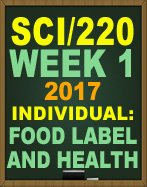 |
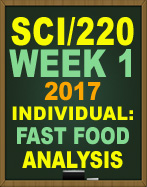 |
 |
SCI/220 Human Nutrition Week 1 Food Label and Health
*Purchase Includes everything listed for Week 1*
In this assignment you will analyze food labels, list the nutrient classes
and their functions, and summarize the consequences of over nutrition
and undernutrition.
Fast Food Analysis
Week 1 Quiz in WileyPLUS
|
||
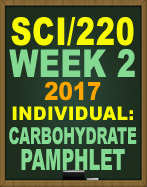 |
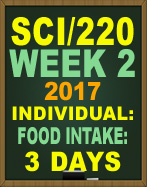 |
 |
COMING SOON! |
||
SCI/220 Human Nutrition Week 2 Carbohydrate Pamphlet
*Purchase Includes everything listed for Week 2*
Create a 2-page pamphlet/brochure using the Microsoft Word,
Microsoft Publisher, Microsoft PowerPoint, Brochure Builder, or
another brochure building tool. Include the following details: fiber in the body. healthy carbohydrate sources. difference can be applied to food selection and consumption so as to improve health. lactose intolerance, diabetes, or hypoglycemia.
Food Intake: 3 Days with the recommendations of the dietary reference intake. which foods might you add or remove to achieve your goal and keep other nutrients in balance? important? servings of foods from each fiber-containing group? contribute to health or illness? Provide examples.
Week 2 Quiz in WileyPLUS
|
||
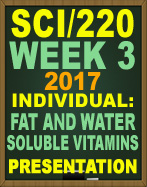 |
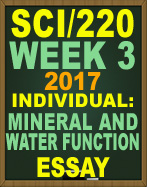 |
 |
SCI/220 Human Nutrition Week 3
*Purchase Includes everything listed for Week 3*
Fat- and Water-Soluble Vitamins Presentation Option#1 - Full Presentation Option#2 - Full Presentation Research the functions, importance, and role of fat- and water-soluble
vitamins. vitamins? vitamins? vitamins? soluble vitamins? body, and the course of action used to treat and manage the disorder. Include speaker notes in paragraph form that detail the implications of
each slide. Each slide should contain no more than six bullets, and at
most six words per bullet.
Mineral and Water Function Essay 2 Options included! and deficiency conditions. iodine deficiency disorders. For your selection, indicate symptoms, required minerals and food sources, people or areas affected, and how the disease is managed or treated.
Week 3 Quiz in WileyPLUS
|
||
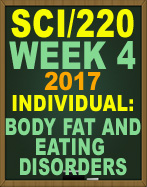 |
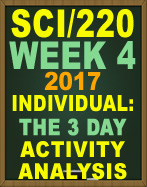 |
 |
SCI/220 Human Nutrition Week 4
*Purchase Includes everything listed for Week 4*
Body Fat and Eating Disorders nervosa, and binge-eating disorder? Explain how each of the eating disorders mentioned may lead to health problems. What are the treatment options for these disorders?
The 3 Day Activity Analysis you surprised by the results, why or why not? through food? Were you surprised by the results, why or why
not? energy expended in your day-to-day activities?
Week 4 Quiz in WileyPLUS
|
||
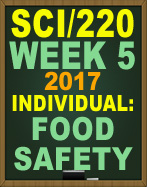 |
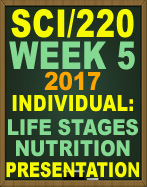 |
 |
SCI/220 Human Nutrition Week 5
*Purchase Includes everything listed for Week 5*
Food Safety Option #1 Word Count: 1,376 words! Option #2 Word Count: 991 words! BONUS - Includes 2 Bonus PowerPoint Presentations on Food Safety! Review food safety scenarios and answer questions in relation to Food
Safety.
Jeremiah's day that could have led him to a serious case of food-borne illness. Point out these areas and briefly explain why they are of concern and what Jeremiah could have done differently. a hamburger not to be cooked all the way through?
likely microorganism responsible for this illness? lead to food-borne illness?
Scenario 3
Save your assignment in the following format FNAME_LNAME-Food
Safety
Life Stages Nutrition Presentation Presentation #1 - 18 Slides with Speaker Notes! Presentation #2 - 16 Slides with Speaker Notes! Presentation #3 - 9 Slides! 3 PowerPoint Presentations Included! Create a 12- to 15-slide Microsoft PowerPoint presentation
discussing the nutritional needs during a person's different life stages
(childhood, adulthood, pregnancy, lactation, and such). Include the
following in your presentation:
Week 5 Quiz in WileyPLUS
6. Docosahexaenoic acid (DHA) and arachidonic acid (ARA) are added as supplements to fortify infant formulas. These fatty acids are added because of which potential benefits? 7. Which of the following can be found in breast milk but not infant formula? 8. The recommended distribution range of fat intake is _______ for 1- to 3-year-olds than for adults. 9. Candice is trying to eat healthier. Which substitution would be an example of a healthier decision? 10. Which of the following statements is correct? 11. Children’s energy and protein requirements ______ as they age. 12. Older adults should consume a diet that is ______ in protein relative to calories as compared to that of younger adults. 13. Which is the primary cause of food-borne illness? 14. Why are nitrites allowed in some foods even though they may form carcinogenic nitrosamines in the digestive tract? 15. Pregnant women need to eat high quality protein like fish, however, they: 16. Because _______ can be contaminated with botulism spores, it should never be fed to infants under 1 year of age. 17. The groundwater has been contaminated by an industrial pollutant. Which of the following animals will have the greatest concentration of the pollutants? 18. All of the following are correct about food insecurity EXCEPT 19. Which of the following is true of under-nutrition? 20. In some cultures, the amount of food available to certain individuals is based on 21. All of the following are advantages of organic farming as compared to conventional farming EXCEPT: 22. Golden rise is a genetically modified variety of rice developed to provide ______ to populations in which the deficiency is prevalent.
|
||
|
||





